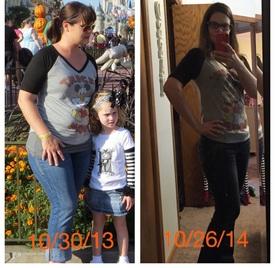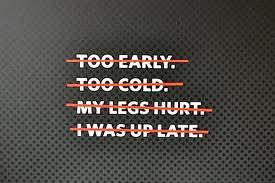GREAT read on plateau-ing!
Replies
-
Thanks! Great info!0
-
What a great article, thanks for sharing. Definitely saving this for later so I'll know how to handle it when it inevitably happens.0
-
bump to read later
 0
0 -
bump0
-
Great post. Thanks for sharing!0
-
bump0
-
Fantastic article!0
-
Thanks learned a lot from this article0
-
Bump!0
-
Thank you for posting! I really needed that!0
-
Wow! This makes sense, thanks for the post. I think this will help.0
-
interesting! bump!0
-
Very easy to understand. Thanks!0
-
No time to read now, but I think I need to, bump bum bump0
-
bump0
-
Bump:)0
-
Thanks, I'll remember this when I hit my plateau. Hasn't happened yet but I know it's bound to happen.0
-
bump-thanks!0
-
Bump.0
-
great read0
-
bump0
-
I really enjoyed this read thank you!0
-
Thank you for the information. I'm saving this to read again.0
-
bump0
-
Bump0
-
Thanks! Bump0
-
Excellent content and food for thought. Gotta feed the mind so the body doesn't plateau! Oh yeah... bump!0
-
fantastic article! thanks for posting0
-
bump!0
-
If you're stuck at a plateau, or just want to be well versed on the topic I HIGHLY suggest the below read. The link to the original text is at the bottom. It made it SO easy to understand how we plateau and what to do to break it -- in terms we can actually understand!
~~~~~~~~~~~~~~~~~~~~~~~~~~~~~~~~~~~~~~~~~~~~~~~~~~
-The Most Dreaded Word In Weight Loss: Plateau-
In the world of weight loss, metabolism is king. Everybody seems to know that a fast one is a good one. Yet, some confusion arises when confronted with the problem of who’s got a fast one, what causes a slow one, and what leads to a metabolism that just won’t do what you want it to do – burn fat!
Every day desperate pleas rain from those in the weight loss trenches begging for advice on how to get the scale moving again. Inevitably, someone is 35 or 40 pounds away from their goal weight, and for some reason, the weight has stopped coming off. Despite adhering to a strict exercise regimen and a 1200-1500 calorie-a-day diet, weight loss comes to a stand-still. Sometimes, the scale reveals a slight weight gain. For three weeks, the scale records no change. What happened? Why did it stop after such a long period of successful weight loss?
According to The Mayo Clinic, a plateau means the body has reached a state of equilibrium. The diet and exercise plan that has worked so successfully for the first round of weight loss must now change. The situation feels nothing short of infuriating. The work and sweat and willpower amount to nothing in the face of a plateau.
So what exactly needs to change? Just like all things with the human body, a one-size-fits-all solution is inappropriate. The Mayo Clinic suggests a further calorie cut or an increase in exercise. After all, weight loss happens when the body burns more than it consumes. Unfortunately, many people on calorie restricted diets exercise to their maximum capacity yet experience the plateau. Suggesting a further cut in calories or increasing exercise proves an irresponsible recommendation. Such a plan could lead to exhaustion, weight gain, decreased brain function, muscle consumption (ketosis), and inevitably, binging and burnout.
The trick to fat loss is maximizing the body’s potential to burn fat. This involves finding a balance between the three main elements of fitness: nutrient intake, cardiovascular work, and strength building. These three elements work together to supply muscles with glycogen (converted carbohydrates from the liver), build more pathways within the body to bring oxygen and nutrients to the muscles, and adapt the muscles to the stress of strength training by building more muscle fibers. Increased muscle mass consumes more fat. Cardiovascular work increases the body’s ability to endure longer periods of exercise more efficiently, making muscles more efficient fat burners. The human body can accomplish these two goals only when fed properly.
When one of these elements falls out of balance, the body adjusts to the change and adapts, as the body’s main goal is equilibrium. The goal in weight loss is to change that equilibrium point to a place of healthy weight and body fat, strong muscles, and healthy nutrient intake.
In my experience, the solution to ending a weight-loss plateau means modifying the most extreme measure of the current weight loss plan. What is the most extreme part of a plan? It’s the part of a plan that a dieter does too much or too little. It’s an extreme of too many or not enough calories, cardio work, or strength training.
For example, a relatively sedentary person initially gained weight by consuming more calories than they burned. The extra calories were stored as fat. Though counter to what we’ve been taught, their bodies actually adapted to the excess caloric intake by increasing the metabolism. Because of the extra weight, their body was forced to work harder to maintain normal body functions. Working hard uses more energy. Even with an increased metabolism, without exercise, their extra calories were stored. To take the weight back off, the first obvious solution is to identify the extreme. In this case, the extreme is excess calories, and the solution is to decrease calories. The body then adapts by lowering the metabolism to reach a balance with new, lower caloric intake. Because the process of lowering the metabolism is gradual, the body makes up the metabolic deficit with body fat. In short, the body begins consuming fat to fill energy needs in the face of minimal caloric intake. When the body has lowered the metabolism enough to accommodate the new caloric intake, the unsuspecting dieter reaches a plateau.
So, dear readers, if you’ve hit a plateau, what part of your fitness regimen needs a change? The following example is based on a real-life person on a weight loss journey as they hit a plateau.
John made the decision to lose weight when the scale tipped 240 lbs. In an effort to get to a healthy weight of 180 lbs., he decided to go from a 3,700 calorie a day diet to a calorie-restricted diet of 1500 net calories, meaning that he would have 1500 “leftover” calories after he exercised. His body needed these "leftover" calories to perform normal body functions like breathing, digesting, and thinking. So, if he burned 700 calories on the treadmill, he would consume 2200 calories. He exercised 5 days a week and strength trained twice a week. He eliminated processed foods from his diet and consumed an abundance of fresh fruits, vegetables, beans, and lean proteins. He lost 38 pounds but still had about 20 to go. He's been losing weight steadily for about 7 months. Now, the scale hasn’t budged in three weeks. He’s tired and frustrated and feels like he’s working hard for nothing! He’s got no idea what to do!
To start identifying the extreme, let’s look at the three elements of John’s weight loss journey.
John engages in cardiovascular work 5 days a week. That’s great! His heart rate doesn’t exceed 85% of his maximum (220-your age), and he works out for about 45 minutes each time. John strength trains twice a week, so he’s building more muscle to burn fat, increase bone strength, improve posture, and maximize his efficiency in movement. Both of these activities serve to increase John’s metabolism. These are both reasonable amounts of work. Attempting to increase either may lead to burnout, exhaustion, injury, or even weight gain because John’s caloric intake is still restricted. His decreased calories are now keeping his metabolism lowered. To raise his metabolism without exhausting himself, he must consume more calories. In the same way that he raised his metabolism while gaining weight, he will now do the same thing and lose weight. Only this time, cardiovascular work and strength training will prevent his increased calories from being stored as fat. By increasing his calories, John gives his muscles more energy to consume fat. In a few weeks or months, when he reaches a plateau, signaling that he’s at equilibrium again, he’ll need to increase his calories again. By that time, he might have reached his “goal weight”, so this final increase may be to reach the number of calories he’ll need to maintain.
Note that John did not increase his exercise and his calories. He increased one only - caloric intake. He increased his calories from 1500 to 1800, still several hundred calories shy of his final number (go halfway down). He'll still be at a caloric deficit, and thus, will continue to lose weight. While increasing calories is terrifying to someone attempting to lose weight, consistent cardiovascular and strength training will prevent weight gain.
John may represent many dieters on restricted-calorie plans. Others’ extreme may be cardiovascular work. They may work out intensely upwards of 7-8 times per week, leaving the body precious little time to heal and repair. In that case, decreasing exercise and/or intensity a few times a week might be best, or again, increasing calories. Some may eat enough and only do cardiovascular work exclusively. For them, incorporating strength training into their regimen will push them from the plateau onto the losing path again. In all of these cases, water consumption is essential. Water mobilizes fat so that muscles can access it easily. Without water, blood pumps like sludge and causes your body to work less efficiently.
Here are some general guidelines to identifying the extreme in your weight loss plan. Modifying this extreme is the likely solution to further your weight loss.
You may need to consume more calories if:
· You exercise regularly (4+ times per week), strength train 2-3 times per week, and are on a calorie-restricted diet, but you do not consume the minimum calories plus most or all of the calories you burn through exercise
· You consume less than 1200 at least once a week
· You consume less than 1500 calories most days of the week
· You regularly consume fewer calories than your BMR (basal metabolic rate)
· You have headaches, lethargy, aches, and/or lack of concentration
You may need to change cardiovascular work if:
· You are mostly sedentary
· You engage in cardiovascular work fewer than 4 times per week
· Your cardiovascular workouts last shorter than 20 minutes
· Your heart rate does not remain in the 55-70% max. range at least two times per week
· Your heart rate does not remain in the 70-85% max. range at least three times per week
You may need to modify strength training if:
· You do not currently engage in strength training
· Your weights seem very light, thereby not stressing your muscles
· You have reached your goal weight, but still feel “flabby”
This article is not a comprehensive study in why we lose. The plateau is but one obstacle in the path to health. Weight loss takes tremendous willpower and strength. Those who accomplish the goal of changing their lives through increased health are true champions, and those in the midst of the battle are nothing short of warriors. While the fight gets confusing when what has been working suddenly stops, your body, your heart, your bones, and your muscles all work best when the excess weight is gone. You can work through this frustrating time by resetting your equilibrium point. As you review your caloric intake and reflect on your exercise regimen, you can now identify the caloric, cardiovascular, or strength extreme and make the change that will move you back onto the path of weight loss.
See the article in it's original location here: http://fitnesswithnatalie.blogspot.com/2011/05/most-dreaded-word-in-weight-loss.html - She also links to BMI/BMR calculators in the text on her page.0
This discussion has been closed.
Categories
- All Categories
- 1.4M Health, Wellness and Goals
- 398.2K Introduce Yourself
- 44.7K Getting Started
- 261K Health and Weight Loss
- 176.4K Food and Nutrition
- 47.7K Recipes
- 233K Fitness and Exercise
- 463 Sleep, Mindfulness and Overall Wellness
- 6.5K Goal: Maintaining Weight
- 8.7K Goal: Gaining Weight and Body Building
- 153.5K Motivation and Support
- 8.4K Challenges
- 1.4K Debate Club
- 96.5K Chit-Chat
- 2.6K Fun and Games
- 4.8K MyFitnessPal Information
- 13 News and Announcements
- 21 MyFitnessPal Academy
- 1.6K Feature Suggestions and Ideas
- 3.2K MyFitnessPal Tech Support Questions


























